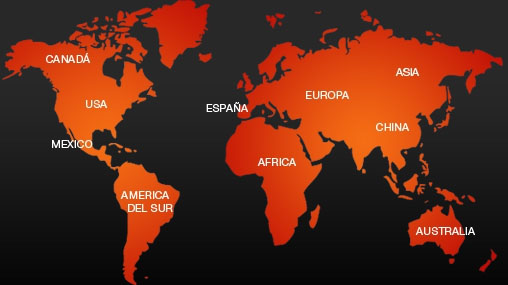- Inicio Acerca de RM Minerales
- Galería de fotos Blog RM Contacto
- Microscopia e instrumentos Pedidos Aviso legal
Copyright 2010-2025
www.rosellminerals.com



Los ejemplares de cuarzo amatista de esta antigua mina murciana son muy apreciados entre los coleccionistas. En este ejemplar podemos observar diversos cristales de cuarzo biterminados, con el color amatista mostrando cierta zonación, más intensa en las puntas. El brillo es muy bueno.
Grupo de cristales de galena con formas del cubo y el ocatedro, redondeadas y salpicadas de numerosos brillantes cristales de esfalerita, con maclas cíclicas que le dan una apariencia hexagonal muy curiosa.
Muy rico ejemplar formado por numeroso y brillantes cristales de pirolusita de aspecto tabular y que forman crecimientos globulares. Con etiqueta de Joan Viñals.
Grupo de cristales de azufre de buen tamaño procedentes de una localidad clásica española, pero de un yacimiento poco conocido, que muestra una gran riqueza de caras, brillo y un color amarillo canario. Se dispone en una cavidad con cristales de calcita. Una pieza española de calidad.
Sin duda estos son los mejores ejemplares de romanechita que se hayan encontrado nunca en España. Se trata de agregados botrioidales de romanechita, brillantes y muy estéticos. Con análisis que enviaremos al comprador.
Agregados globulares de cristales prismáticos de barita, brillantes, definidos, translúcidos y con un color blanquecino. Un clásico de la minería murciana.
Grupo de cristales de yeso, en crecimiento paralelo, con inclusiones de siderita. Explotación a cielo abierto (corta) situada junto a la corta San Valentín. Procede de la colección de Joan Astor.
Agregados globulares de color blanco a azulado de arsenocrandallita, se acompaña de yukonita de color marrón. Estos ejemplares fueron los primeros que Joan Viñals analizó de est clásica mina murciana y que llevaría al descubrimiento de la barahonaíta (la de Al y de Fe). Con la etiqueta manuscrita.
Estético ejemplar que combina una parte superior de agregados botroidales de goethita, con brillo semimate, y una parte inferior con crecimientos estalactíticos de óxidos de manganeso. Se acompañan de hematites de intenso color rojo y barita. Un ejemplar poco habitual para los coleccionistas de la "Sierra".
Muy rico agregado de cristales aciculares de yuanfuliíta, de color rojo anaranjado. Se acompañan de cristales globulares y brillantes de calcita, hematites y cristales perfilados de richterita/fluororichterita y diópsido de color amarillo. De esta clásica localidad española.
La Corta Brunita, en Murcia, es un clásico de la minería española. Este ejemplar nos muestra diversos agregados globulares de cronstedtita, formados por pequeños cristales con las caras terminales triangulares. Se disponen sobre una matriz con smithsonita.
Sin duda estos son los mejores ejemplares de romanechita que se hayan encontrado nunca en España. Se trata de agregados botrioidales que nos muestran una superficie aterciopelada, formada por diminutos cristales de romanechita/pirolusita. La romanechita presenta en fractura fresca el clásico color gris. Sobre la superficie de las estalactitas podemos observar pequeños pero brillantes cristales de pirolusita. Estas muestras no han sido tratadas, solo se han lavado con agua. Los análisis se enviaran al comprador.
Agregado de cristales tabulares de barita, brillantes, definidos y entre translúcidos a transparentes en las aristas. De una localidad clásica de la mineralogía española.
Rico ejemplar formado por numerosos agregados de cristales pseudohexagonales de barita, gruesos, con brillo, color blanco a amarillento, que destacan sobre una matriz de goethita. Los ejemplares de barita de esta mina son muy apreciados por los coleccionistas. Este ejemplar procede de la colección J. Astor (Barcelona). Con etiquetas antiguas.
Vistoso ejemplar en forma de agregados estalactíticos divergentes, con una pátina de óxidos de manganeso en su parte posterior. Una pieza muy curiosa de esta mina murciana.
Cristal muy aéreo de yeso de esta clásica localidad murciana. Destaca por su transparencia, brillo y por las inclusiones bien visibles. La "matriz" está formada por un grupo de cristales de la misma especie mineral.
Un ejemplar muy notable por el tamaño de los cristales de pirolusita, los cuales forman brillantes agregados. En alguna zona se hallan parcialmente recubiertos por pequeños agregados botroidales de goethita, negra y muy brillante. Un place bajo la lupa.
Este ejemplar nos muestra un interesante conjunto formado por una calcedonia botriodal de color azulado, muy brillante, que se halla parcialmente recubierta por agregados de cristales de calcita, aplanados, en crecimiento axial, y con una transparencia y brillo excelentes. Un digno ejemplar de esta explotación minera casi desaparecida lindando con la corta San Valentín. Una pieza muy estética de esta clásica zona minera murciana.
Buen ejemplar formado por diversos óxidos de manganeso, con cristales tabulares de pirolusita formando brillantes rosetas, sobre agregados botrioidales de romanechita-pirolusita. Una buena y antigua pieza. Adquirida por el Sr. Manchion en la antigua feria de minerales que se realizó en 1985 en L'Hospitalet de Llobregat.
Sin duda estos son los mejores ejemplares de romanechita que se hayan encontrado nunca en España. Se trata de agregados botrioidales que nos muestran una superficie aterciopelada, formada por diminutos cristales de romanechita/pirolusita. La romanechita presenta en fractura fresca el clásico color gris. Sobre la superficie de las estalactitas podemos observar pequeños pero brillantes cristales de pirolusita. Estas muestras no han sido tratadas, solo se han lavado con agua. Los análisis se enviaran al comprador.
Estos ejemplares de barita de tono anaranjado son un clásico de la mineralogía de la zona de La Unión-Cartagena. Esta pieza destaca por el intenso brillo y una marcada zonación de color, que presenta bandeados en los cristales tabulares que forman estéticas rosetas. Muy elegante ejemplar.
Nutrido grupo de cristales de barita, con crecimientos estalactíticos escalonados, de intenso blanco, con caras y aristas definidas y formando una estética "cresta". Muy buen tamaño.
Nutrido grupo de cristales de barita, con crecimientos estalactíticos escalonados, de intenso blanco, con caras y aristas definidas y formando una estética "cresta". Un clásico español, diferente de lo habitual.
Sin duda estos son los mejores ejemplares de romanechita que se hayan encontrado nunca en España. Se trata de agregados botrioidales que nos muestran una superficie aterciopelada, formada por diminutos cristales de romanechita/pirolusita. La romanechita presenta en fractura fresca el clásico color gris. Sobre la superficie de las estalactitas podemos observar pequeños pero brillantes cristales de pirolusita. Estas muestras no han sido tratadas, solo se han lavado con agua. Los análisis se enviaran al comprador.
A buen seguro, estos son los mejores ejemplares de romanechita que se hayan encontrado nunca en España. Se trata de agregados botrioidales que nos muestran una superficie aterciopelada, formada por diminutos cristales de romanechita/pirolusita. La romanechita presenta en fractura fresca el clásico color gris. Sobre la superficie de las estalactitas podemos observar pequeños pero brillantes cristales de pirolusita. Estas muestras no han sido tratadas, solo se han lavado con agua. Los análisis se enviaran al comprador. Buen tamaño.
